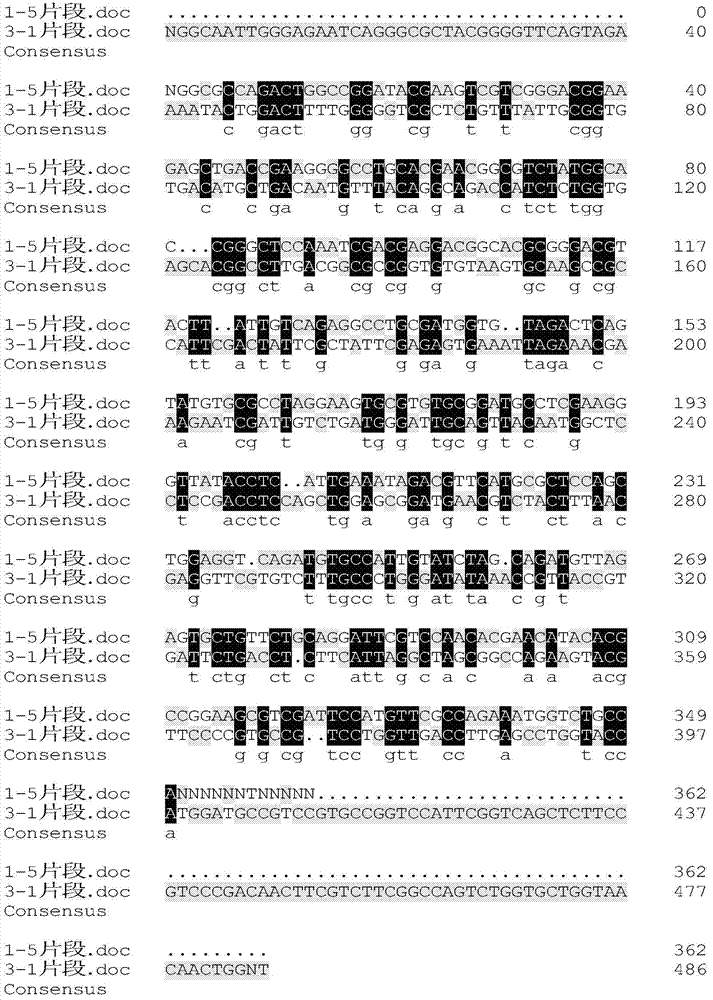Specificity SCAR marker for detecting puccinia striiform
A wheat stripe rust and labeling technology, applied in the fields of biotechnology and plant quarantine, can solve the problems of difficulty in defining the period and scale of initial infection, time-consuming and labor-intensive, and indistinct differences in symptoms at the seedling stage, etc.
- Summary
- Abstract
- Description
- Claims
- Application Information
AI Technical Summary
Problems solved by technology
Method used
Image
Examples
Embodiment 1
[0059] Example 1. Extraction of wheat pathogenic fungus genomic DNA (gDNA)
[0060] use and so on.
[0061] The gDNAs of the three wheat rusts and powdery mildews were extracted from the susceptible wheat leaves in the latent incubation period and the uredospores or conidia of the pathogenic fungi, and the gDNAs of other wheat pathogenic fungi were derived from the vegetative hyphae. The susceptible wheat leaves or vegetative mycelia were directly frozen and ground into powder with liquid nitrogen, and the spores of rust fungus and powdery mildew were broken by glass bead shaking, and the rest of the DNA extraction operations were carried out according to conventional methods. After digesting RNA with an appropriate amount of RNase, the quality and concentration of gDNA were determined by UV spectrophotometry.
Embodiment 2
[0062] Embodiment 2.PCR comparative analysis and the cloning and sequencing of wheat stripe rust specific nucleic acid sequence
[0063] Referring to the report of "Glass and Donaldson, 1995." on conserved genes in fungi, synthetic primers Bt2a / Bt2b, the nucleotide sequence is: Bt2a: 5'-GGTAACCAAATCGGTGCTGCTTTC-3', Bt2b: 5'-ACCCTCAGTGTAGTGACCCTTGGC-3'.
[0064] PCR analysis was carried out on the PTC2220 PCR instrument of MJ Research, Inc.
[0065] The PCR amplification system for gDNA of wheat stripe rust, leaf rust fungus and stem rust fungus is 25 μL, including 2 μL of 10×PCR Buffer (Mg2+Plus), 0.3 μL of dNTP Mixture (each 2.5 mmol / L), Bt2a / Bt2b (10μmol / L) 1μL, template DNA (20ng / μL) 1.0μL, TaKaRa Taq (5U / μL) 0.3μL, ddH2O 16.9μL.
[0066] The PCR reaction conditions were: 94°C for 2 min, 1 cycle; 94°C for 15 s, 55°C for 30 s, 72°C for 90 s, 30 cycles; 72°C for 10 min, 1 cycle.
[0067] The amplified products were separated by agarose gel with a mass fraction of 1.5 and ...
Embodiment 3
[0069] Example 3. Obtaining and Specificity Verification of Wheat Stripe Rust SCAR Marker
[0070]According to the specific DNA fragment sequence of wheat stripe rust obtained by PCR comparison and amplification, the specific primer TF144G / TF323G was designed and screened, and its nucleotide sequence was:
[0071] TF144G: 5'-CCTGCGATGGTGTAGACTCA-3',
[0072] TF323G: 5'-CGGCGTGTATGTTCGTGTTG-3',
[0073] Submitted to Beijing Saibaisheng Gene Technology Co., Ltd. for chemical synthesis. By further optimizing the PCR reaction system and cycle conditions, a 180bp-specific SCAR marker of wheat stripe rust was obtained.
[0074] The PCR reaction system is: 20 ng / μL template DNA 1 μL, 10 μM primer TF144G 1 μL, 10 μM primer TF323G 1 μL, 2×EasyTaq PCR SuperMix 12.5 μL, ddH 2 O9.5 μL.
[0075] The PCR reaction conditions were: pre-denaturation at 94°C for 4 min; 35 cycles of denaturation at 94°C for 30 s, annealing at 54.5°C for 30 s, extension at 72°C for 1 min, and extension at 72°...
PUM
 Login to View More
Login to View More Abstract
Description
Claims
Application Information
 Login to View More
Login to View More - R&D
- Intellectual Property
- Life Sciences
- Materials
- Tech Scout
- Unparalleled Data Quality
- Higher Quality Content
- 60% Fewer Hallucinations
Browse by: Latest US Patents, China's latest patents, Technical Efficacy Thesaurus, Application Domain, Technology Topic, Popular Technical Reports.
© 2025 PatSnap. All rights reserved.Legal|Privacy policy|Modern Slavery Act Transparency Statement|Sitemap|About US| Contact US: help@patsnap.com



